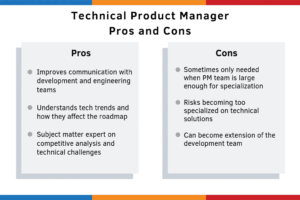The Ultimate Guide to a Product Manager’s Job
No two product managers are alike. They hail from varied backgrounds. They emphasize different aspects of the role and have different styles and interpersonal skills. Some are freshly minted college grads. Some are grizzled veterans making a career change from more technical disciplines. Others are lifers, with war stories and anecdotes to spare.
With so much diversity and range amongst their ranks, pinning down a prototypical product manager is impossible. But you’ve got to start somewhere, keeping in mind the role is vastly different depending on the company; here’s a semi-definitive guide to this oft-misunderstood profession.
What is a Product Manager?
What does a product manager job description look like? Ask ten product managers to describe their jobs, and you’re likely to hear ten different answers. Unlike a schoolteacher or a police officer, “product managers” don’t have a distinct and consistent job description simply because the responsibilities of product managers vary quite a bit across industries and businesses.
Whatever their specific responsibilities, all product managers share a core function: drive the development of products and ultimately be responsible for the success of those products.
We’ve defined a product manager’s job at the highest-level — they drive the development of products — but what exactly does that mean? What do product managers do? Does it change if they’re in B2B vs. B2C?
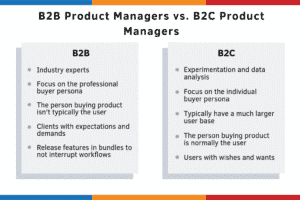
Let’s delve deeper into the product manager’s job.
Strategic direction
Product managers are information gatherers, defining the strategic direction of their products through the lens of knowledge they acquire about:
- Their business’s strategic goals
- The market’s demands and opportunities
- The technological and financial resources available to them to make the product a reality.
Once they have analyzed all this data and determined a strategic direction, the product manager’s job is to communicate this strategy to many stakeholders and to earn buy-in from decision-makers. They then ensure the appropriate teams understand their roles and have the tools they need to execute the product strategy moving forward.
Read the Career Guide for Product Managers ➜
Communicate, coordinate, and persuade
Despite having a consensus on the strategy, the implementation doesn’t just magically happen. Product managers have to fight for attention from development teams, lobby for resources and convince sales and marketing to give their products appropriate love and care.
Without manufacturing momentum, windows of opportunity can close, and competitors can make significant gains. Product management must keep the train moving forward, even though they don’t have any engines of their own.
But this shouldn’t be confused with managing the minutiae of the implementation itself. Product managers are also often asked to play the role of project manager and facilitator. But really, “how” the team delivers is up to them. Product managers are a part of that conversation.
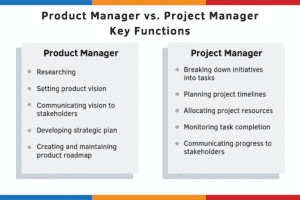
The Technical Product Manager Variant
There is a particular type of product manager known as a “technical product manager.” Other specialized product management titles exist, but this is by far the most common.
Before diving into the specifics of what a technical product manager does, there is an underlying question of whether or not product managers must be technical to do well in the role. There are many viewpoints on the subject. If you’re managing a software or hardware product, then technical skills are seen as a big plus.
The title comes with its own particular set of expectations and responsibilities. A technical product manager is expected to possess significant, practical knowledge about programming, system design, and the like. They should be conversant in the technical solution stack the product uses and hold their own in discussions with the technical team. Their experience helps them avoid the pitfalls of requesting things that are infeasible or too large of an ask for the allotted development cycle. The technical product management role is a common stepping stone for former developers, tech support staff, and architects looking to move into the product management field.
Technical product managers typically exist in larger product management teams. They sometimes own responsibility for a particular part of the product but are also often deployed on an ad hoc basis to manage the technical aspects of different initiatives.
Product Manager Skills
Product management requires a combination of specific hard skills and soft people skills to effectively shepherd a product through the various phases of its lifecycle.
Product development processes:
A concrete understanding of the role and product development processes and frameworks is essential. Before finessing the interpersonal dynamics of working with a product development team, product managers must be able to speak their language, comprehend the expectations, and know the scope of their job versus that of project managers, UX professionals, architects, and the like.
Pricing principles:
Product managers also need a solid understanding of fundamental business and economic policies. Pricing often falls on their shoulders. If they’re unable to turn the underlying unit economics into a profitable and scalable business, they’ll have a pretty short career.
Prioritization:
Prioritization is at the core of product management. Assessing the relative value and impact of each potential feature, technical debt, project, and initiative, and creating a coherent strategy is the most critical part of the job. A coherent strategy includes being able to say no when the time comes, as well as recognizing the need for a pivot or strategic shift if applicable.
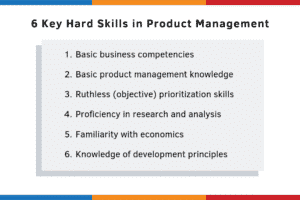
Communication:
On the softer side, communication lies at the heart of any successful product manager. They must be a cipher and be comfortable speaking with all sorts of people filling different roles. They speak with customers, internal teams, and stakeholders. Product managers must get along with engineers and relate to the perspectives of stakeholders.
Conveying a strategy and vision, along with specific plans and their rationale, is vital. Product managers must build consensus, break down (or at least work across) organizational silos, and win over stakeholders to get their job done. More than other roles, product managers deal with the various personality types of individuals that can play a part in a product’s success and growth, or in its crash and failure.
We’ve linked below a great webinar on the Essential Skills all Product Managers Must Master. The discussion covered what a product manager is not, soft skills PMs need to embrace, and the tools of the trade all product managers should know.
A Good PM vs. a Great PM
Without an official certification, specific college degree, or formal training program that authorizes someone as an “approved product manager,” there are a variety of backgrounds in the product management space. For some, this ambiguity is a cherished element of the role. Some are glorified techies, whereas others are all about the market and positioning. Then you have some that are business analysts with some clout, while others are customer-centric idea powerhouses.
How can you tell who’s performing well as a product manager? Great product managers manage to combine all the traits we mentioned earlier. They are universally conversant across many disciplines. They’re also engaged and experienced enough to dive deep into any topic when required.
Read From Product Manager to Product Leader ➜
They can balance the strategic and tactical, without resenting having to delve into either. Most importantly, product managers challenge every assumption and ask “why?” at each opportunity; even if they feel the pressure to “ship” and visibly deliver new products.
Countering Complacency as a Product Manager
Another sign of a great product manager is the refusal to settle for mediocrity. All too often, products are considered “done” once they have the basic functionality envisioned in the strategy and are seeing steady revenue and growth.
But regardless of one’s definition of done, an idling product is destined for irrelevancy. A competitor will come up with a game-changing feature that cuts into its market share, or it will eventually run out of new users. That’s why great product managers are always looking for ways to make products do more, or do it better because there is always still room for improvement.
Download a Day in a Product Manager’s Life ➜
Embrace Prioritization
Product managers must also acknowledge they can’t do everything if they want to achieve greatness. Ask any product manager what some of the most important skills are that get used on the job regularly, and they’ll tell you communication and prioritization. Often, you’re communicating your prioritization.
Prioritizing Product Features
Great product managers also know how to sidestep one of the biggest pitfalls of the profession: offering up opinions instead of relying on data. Product managers never base decisions on “gut feel” or “instinct” alone. While instinct might spark exploration, ultimately, all decisions should be grounded in cold, hard facts.
Read the Product Manager’s Guide to Prioritization ➜
Luckily product managers don’t have to start from scratch when it comes to deciding how to prioritize features. There are a plethora of prioritization frameworks to select from based on personal preference and corporate goals. For example, stakeholders can be forced to make hard trade-off decisions using the buy-a-feature method. Or some quick-and-easy wins can be identified by relying on the value vs. complexity framework.
Here’s a popular quick overview of how the popular prioritization framework MoSCoW works.
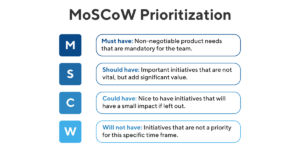
Best of all, there’s no need to pick a single framework and stick with it. Different ones can be employed at different times, providing a fresh way to gain some clarity about what should jump to the front of the queue.
Prioritizing Your Time
Prioritization doesn’t just apply to lists of features and enhancements. It’s relevant when evaluating how they spend their own time, as well. Product managers need time for essential things and deep thinking. Updating status reports and dashboards don’t qualify. There are some productivity hacks to improve the situation. Follow the 4 D’s: do it, delegate it, defer it, or delete it is a good one for any product manager trying to get back some time.
Getting Started in Your Role
A newly hired product manager will find themselves “drinking from the firehose” before they’ve even had time to unpack their tchotchkes. In this kind of cross-functional role, there is so much to do all at once. And so much groundwork to lay before it can get done.
Sometimes new product managers may have the urge to make a splash and big impression right out of the gate. But acting too hastily might hurt their credibility before they’ve even had a chance to build it up.
A savvier move is creating a strong foundation for future success by not trying to come in and take over. There are an established culture and pecking order to be unpacked. Identify and understand the players before being overturned.
Learn your product inside-out
Beyond that, intimate knowledge of the current product is an absolute necessity. Product managers should know how it works, why it works that way, and how customers are using it. Spending time with customer service, shadowing sales calls, and meeting actual customers are always right moves in those early days on the job.
Onboarding
Onboarding for product managers isn’t always great and there often isn’t a pre-baked script to follow.
While there are lots of things new product manager hire should consider doing in the first month, some are absolute musts. To get the lay of the land, product managers should strive to meet as many coworkers as possible, reserving any judgment for the moment and merely probing and listening. Bonus listening and learning opportunities are sitting in on customer calls or interviewing friendly customers.
Of course, executing a personal strategy doesn’t just happen. It takes planning and time that is often in short supply. That’s why product managers shouldn’t shortchange themselves. There’s value in setting aside enough time all year long to take care of the tasks likely to fall by the wayside once they get into the thick of it all.
Mapping user journeys
One way product managers can fully understand how their products fit into the lives of their customers is by creating a journey map. This journey begins long before users start using their products. That’s why it’s an excellent exercise for a product manager new on the job.
Journey maps look at user personas versus buyer personas. They contemplate how users first learn about a product’s existence and their path to purchase. The road to purchase includes marketing awareness and education about a product’s value proposition.
From there, the journey map spans the actual acquisition of the product; training, onboarding, and initial usage. Looking at all these steps can uncover friction points. Product managers can address those through new or improved functionality, documentation, proactive support, and customer services.
Journey maps also include the mature stage of usage and how products fit into the everyday routines of their users, revealing additional opportunities for enhanced user experience. It’s also key to finding the most promising possibilities for extending the product to become more useful and loved by users.
Communication with Your Stakeholders
A product manager can have the perfect strategy, an exciting roadmap, and reams of market research and data. But that alone doesn’t guarantee success. In business, nothing moves forward without building consensus and managing the expectations of your team of stakeholders. Remember, you are building someone else’s vision, and that you need the help of all of your stakeholders to achieve that. Refine, adapt, accept what you cannot change, and most importantly, over-communicate. Here’s a quick infographic that differentiates two common ways to communicate with your team and stakeholders.
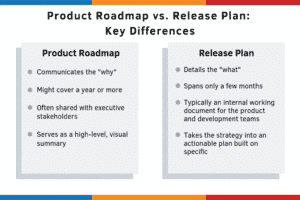
Listening to Your Stakeholders
Product managers must hear and appreciate the concerns and motivations of stakeholders. Their unique perspectives and opinions help shape the company’s overall point of view, while their demands can’t be ignored in plans for the product.
Just as important as speaking the dialects of each constituent group involved in their product’s development, product managers must also be able to understand those dialects. Of course, this requires excellent listening skills. Because information gathering and analysis are such an essential part of the job, any product manager job description must include excellent research and listening skills.
Product managers also need to understand the subtleties of each dialect — both to be sure their teams genuinely appreciate their respective roles. So product managers themselves can quickly identify a potential issue before it becomes a real problem.
Product Managers use narratives to tie everything together because it creates an emotional investment in the outcome. With persuasive storytelling, stakeholders build empathy with users. They see the full benefits a product can deliver and how it fits into the broader context. They begin to care about how the story will end, and they’re willing to help it end happily.
Speaking with Stakeholders
A large component of a product manager’s job is to coordinate among many disparate groups of constituents. Their constituents might be executives, sales reps, customers, development or manufacturing teams, marketing personnel, etc. A product manager ensures that all of these groups understand their roles and are working toward a common strategic goal.
But these groups often speak their own dialects. Executives think and talk in terms of quarterly projections, investor returns, and satisfying industry analysts or Wall Street. While engineers talk about software code and other technical details.
Successful product managers must speak fluently in all of these business dialects for a clear articulation of expectations from each team in a mutually understood context.
Clear two-way communication between product managers and stakeholders is a must for developing and strengthening these relationships. Even if they don’t all like each other, respect and credibility are the minimum threshold required for a functional organization and product development process. To effectively integrate stakeholders, they should be engaged at every point in the process. During the planning phase, it’s best to make them aware of where things are heading and why with a roadmap (which is different than a release plan). Theme based roadmaps are especially useful for storytelling as it rolls up features into the larger, “Why?” theme.
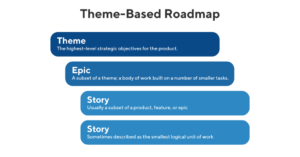
This time spent communicating with stakeholders is both a tone-setter for future discussions as well as an opportunity to get contradicting input early on.
4 Things to Remember About Stakeholder Communication
- Consensus comes from winning over and convincing stakeholders that your roadmap plan is rock solid.
- The narrative must address outstanding concerns.
- The emotion product managers most want to trigger is excitement.
- Focuses on the big picture promise of the product or feature.
If a product manager can’t create and deliver a story that has those elements then they need to go back to the drawing board. It will be too hard to get stakeholders on board. It’s even harder to get them motivated to spend a little more, work a little harder, and take a few more risks.
Frustrating Aspects of the Job
Maintaining professionalism can be tough. There are plenty of frustrating events in the life of a product manager, and many of them are entirely out of their control.
Here are some product managers struggle with:
- Company vision can be blurred and change quickly so it can be hard to have a proactive strategy when you’re often charged with reactive tasks under small time constraints.
- You’re always under a pressure cooker from the engineering and design teams in a way that can test your confidence and make you feel like an imposter.
- Internal politics are a large part of the role and for many, it can distract from the parts of the role they like better.
- Product managers should be sure they don’t let their emotions get the better of them. Otherwise, they might lose all their hard-won credibility. It’s often prudent to bite your tongue. Product managers shouldn’t find themselves letting any of these things they want to say out loud slip in the workplace, no matter how frustrated they get.
- Too often, product managers assume if it’s anything they can do, it’s something they should do. But these tasks are usually a poor utilization of their unique skillset and could be offloaded to someone else.
- There will always be chaos. Some product managers thrive under the organized-chaos and enjoy it.
- You will need to be an expert in the product. Everyone will turn to you for answers and you will need to consistently come up to bat with your reasoning.
Continuing Your Product Manager Education
A product manager’s education is never complete. There are always more things to learn and more people to learn from. As the profession has matured, many resources have sprung up to support both newbies and veterans.
When product managers want to delve into the world of self-improvement and career development, there is a slew of books on the topic, providing tips, pointers, and insights from experts.
For those looking for something a little shorter and more timely, a bevy of blogs is the go-to resource for diving into a different topic or learning lessons from the travails of others.
If audio ingestion of product management wisdom is preferable, product management podcasts may be the answer. They’ll turn an uninteresting commute into a learning platform or that refreshing afternoon walk into a master class.
And if instant gratification, memes, and inspirational quotes are just what the doctor ordered, Twitter is always there to deliver. These female product management thought leaders make for great follows. There are also many Slack communities for product managers to chat with their peers.
Takeaway
There are days you’ll love the role and days you’ll wonder why you do it. It’s worth the while when all the pieces come together because even with those challenges it’s one of the best jobs out there. You get to use all your skills, be a vital asset to your team, and use both sides of your brain.

